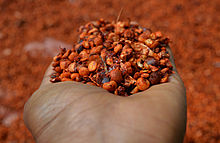Shiro (food)
 Shiro served upon injera is a staple food of Eritrean and Ethiopian cuisine | |||||||
| Type | Stew | ||||||
|---|---|---|---|---|---|---|---|
| Course | |||||||
| Place of origin | |||||||
| Main ingredients | |||||||
| Variations | Shiro fit-fit | ||||||
| 353 kcal (1478 kJ)[1] | |||||||
| |||||||

Shiro (Ge'ez: ሽሮ, romanized: šəro), also called Shiro Wat (Amharic: ሽሮ ወጥ, romanized: šəro wäṭ), or Tsebhi Shiro (Tigrinya: ጸብሒ ሽሮ, romanized: ṣäbhi šəro), is an East African stew. Its primary ingredient is powdered chickpeas or broad bean meal and often prepared with the addition of minced onions, garlic and, depending upon regional variation, ground ginger or chopped tomatoes and chili-peppers. Shiro is served atop injera (leavened flatbread) or kitcha (unleavened flatbread). Tegabino shiro is a type of shiro made from heavily spiced legume, chickpea, field pea, or fava bean, oil (or butter), and water. It is brought bubbling to the table in a miniature clay pot or shallow aluminum pan. It is often consumed with dark or sergegna injera.[2]
Shiro can be cooked and added to shredded injera or taita and eaten with a spoon; this version is called shiro fit-fit. Shiro is a vegan food, but there are non-vegan variations that use niter kibbeh (a spiced, clarified butter) or meat (in which case it is called bozena shiro).
Shiro is an essential part of Eritrean and Ethiopian cuisine. It is a favorite dish during special occasions, including (Lent), Ramadan and other fasting seasons.
See also[]
- List of African dishes
- List of legume dishes
- List of stews
 Food portal
Food portal
References[]
- ^ "Habesha Food | Miten Shiro | purchase online".
- ^ McCann, James C. (2009). Stirring the Pot: A History of African Cuisine. Ohio University Press. p. 104. ISBN 9780896804647.
- Ethiopian Millennium (electronic version, retrieved 19 June 2007)
- Ethiopian cuisine
- Legume dishes
- Stews
- Chickpea dishes
- Eritrean cuisine
- Ethiopia stubs
- African cuisine stubs